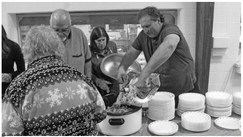Celebrate manufacturing in Wisconsin
By Editorial Board
Wisconsin’s economic strength rests on a three-legged stool of manufacturing, agriculture and natural/human resources.
As anyone who has tried to build a stool or fix a broken one can tell you, without all three legs remaining strong and secure, the stool will not stand or support any weight. However, when all three are strong, the stool will be able to bear whatever load is needed.
As such, October is manufacturing month in Wisconsin. It is the time taken each year, to celebrate the role manufacturing has in the state, and its positive impacts on people and communities.
According to the most recent report from the National Association of Manufacturers (NAM), manufacturers in Wisconsin, account for 18.95 percent of the output in the state, employing 16.76 percent of the workforce. Output from manufacturing was $66.32 billion in 2021. According to preliminary reports from the Bureau of Labor, there were 480,000 manufacturing employees in Wisconsin, in July 2023.
Items made in Wisconsin, are used around the country and around the world. If you travel to South Korea, you can see windows produced by Sierra Pacific at their central Wisconsin facilities. Frozen pizzas from Wisconsin, fill hungry stomachs across the country.
The ubiquitous cardboard boxes delivered to people’s front porches are made in Wisconsin paper mills, as is toilet paper, copy paper and all manner of paper products. If you have ever opened a refrigerator door or touched the console buttons in a motor vehicle, you have used products manufactured in Wisconsin.
In its most basic level, manufacturing takes raw materials, and through labor and industrial might, makes them into a host of products. Some of those products, like pharmaceutical or medical equipment, are literally lifesaving. Others, like pallets, plywood and heat exchangers, are just as necessary, but far less flashy. While others, such as high-end fishing poles, outboard motors and custom boats, make life a lot more fun.
The statistics about the dollars and cents of factory output, and number of people employed, by itself, tells an incomplete picture of the impact of manufacturing on the state’s economy. Manufacturing a is foundational engine in local economies.
By transforming raw materials into something new, manufacturers add value and in the process, create real wealth in a community. This, in turn, is paid out in wages to workers, and goes to the suppliers and vendors, who provide equipment and services. This wealth forms the backbone of the local tax base, generating revenue to keep roads plowed and municipal services intact.
The impact doesn’t stop there. Through the economic multiplier effect, every dollar added to the local economy circulates and grows in impact, with its spending. The worker buys things at the local store, visits the local tavern, goes out to eat at the local restaurant or hires a contractor to build a house. These actions, in turn, spawn further positive economic growth.
Manufacturing is an essential part of Wisconsin’s economic strength. Wisconsin leaders and those elected to represent Wisconsin in Congress, must work to support policies that keep Wisconsin factories open and their workers producing, by reducing barriers to trade, and encouraging access to raw materials and labor.
Manufacturing is a key part of Wisconsin’s economic strength and should be celebrated.
Members of the Courier Sentinel editorial board include publisher Carol O’Leary, general manager Kris O’Leary and Star News editor Brian Wilson.

